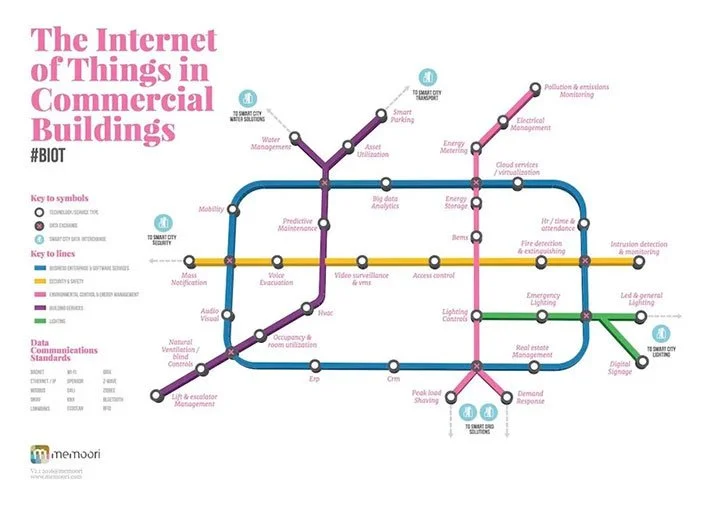5 Ways the Convergence of IPMVP and IoT Increases Energy Savings
The convergence of IPMVP and IoT provides huge energy saving prospects for commercial buildings. But before we dive in to those prospects, let’s first take a look at what the concepts of IPMVP and IoT imply, leading up to the possible outcome of their convergence.
What is IPMVP?
The International performance measurement and verification protocol generally referred to by the acronym IPMVP defines standard terms and suggests best practice for quantifying the results of energy efficiency investments and increase investment in energy and water efficiency demand management and renewable energy projects. The protocol which is published annually by the Efficiency Valuation Organization (EVO) is the result of corporations between several international energy efficiency agencies. The IPMVP is usually published in three volumes and has an objective to develop internationally applicable standards for the verification claimed by energy performance contracts and energy saving companies.
IPMVP Volume I
Defines Measurement and Verification (M&V), presents the fundamental principles of M&V, and describes a framework for a detailed M&V Plan. It also outlines the requirements for the use of IPMVP or claiming adherence with IPMVP. Furthermore, it contains a summary of common M&V design issues and lists other M&V resources.
IPMVP Volume II
Provides a comprehensive approach to evaluating indoor environmental quality issues in line with ECM design, implementation and maintenance. It also suggests measurements of indoor conditions to identify changes from conditions of the baseline period.
IPMVP Volume III
Provides greater detail on M&V methods associated with the construction of new buildings and with renewable energy systems added to existing facilities.
Advantages of IPMVP
Based on its mission, vision and execution, IPMVP has the following advantages:
1.Harmonization of energy conservation measures:
Prior to the creation of the IPMVP protocol, there was no generally acceptable standard for the measurement of energy and water savings by commercial buildings. Different actors in the industry claimed different standards with each one claiming themselves as the best in terms of energy conservation. Lacking the skills or tools with which to check the accuracy of the readings provided by these different actors, managers of commercial buildings often than not were preyed upon by these actors who usually provided wrong data with respect to energy savings. The IPMVP like a meter rule is the world’s leading generally acceptable standard for the measurement of energy and water savings in the commercial building industry.
2. Reduction in planning cost and time
Before commencing with the construction of a commercial building, a significant amount of time is often spent in planning. Given that duration plays a role in the cost of planning, commercial building owners and contractors spend a lot of time in planning and optimizing resources in order to construct the most energy efficient building. Given that the IPMVP already outlines the best practices through which to save the most in energy and water, the cost associated with planning the construction of a commercial building can be significantly cut down through the direct implementation of the protocols outlined in the IPMVP.
3. Increases the value of commercial buildings
IPMVP is a widely acclaimed protocol available in over 10 languages and largely accepted and recognized by several countries all over the globe. Hence, by constructing a commercial building in line with IPMVP or valuing the energy saving of a commercial building using these protocols increases the building’s value. This value increase comes about because the results of the valuation if positive will be widely acceptable as opposed to if another less popular and less acceptable protocol were used.
One of the definitions of IoT as defined by IBM is as follows:
“…the concept of connecting any device (so long as it has an on/off switch) to the Internet and to other connected devices. The IoT is a giant network of connected things and people – all of which collect and share data about the way they are used and about the environment around them.”
With the help of the interconnected devices and systems within a commercial building, IoT can be used to improve energy savings and efficiency within the building.
Typically, IoT leverages the interconnectivity between the sensors and actuators in different devices within a commercial building, in consideration with occupant needs and building efficiency goals through an IoT platform, that results in energy savings. This process and the concept of automated actions based on preset baselines is what is generally referred to as Smart Buildings. This concept is illustrated in the diagram below
5 Ways through which IPMVP and IoT Convergence Increases Energy Savings
1. Building Modeling
IPMVP is all about the best protocols through which buildings can accomplish the most energy and water savings, in an effort to increase investments in commercial buildings and standardize energy savings measurement. To effectively and efficiently accomplish these goals, IPMVP protocols will have to take in to consideration the latest trends in building technology. Currently, the latest technological trend making waves and causing so much buzz in the commercial building sector is IoT. IPMVP protocols when combined with IoT data from an IoT platform leads to the development of enhanced protocols which takes into consideration all the parameters (technical and technological) in modeling the ideal IPMVP compliant commercial building.
2. Standardization of Energy Savings Measurements
One of the key points on which the popularity of IPMVP strives is its standardization of energy savings measurements. The importance of this standardization cannot be over emphasized as it puts in place a framework of procedures through which energy and water savings measurements can be ascertain across commercial buildings all over the world. However, accurate and complete measurements will always need some form of automation, as it is an impossible feat to achieve it with a manual process. Through the incorporation of IPMVP measurement standards in to an IoT platform, commercial buildings can set in place automated actions, as well as have real time data on energy savings in the building as a whole and its sectors in particular.
3. Efficient Execution of IPMVP protocols
Everyone in the 21st century is obsessed with data and information. Alongside this obsession is the desire for instant delivery. IPMVP protocols get released only once a year. However, during the period leading up to its next publication, there are always advancements which commercial buildings could implement on the go while waiting on the next publication. Leveraging the IoT, IPMVP protocols could be set as baselines on the IoT platform, with projections of outcomes based on possible modifications. By so doing, commercial buildings could know the exact impact of new technological innovations on their energy savings in the period leading up to the new IPMVP publication. Commercial buildings can therefore autonomously take decisions and implement new energy saving strategies based on IoT projections, while waiting on the next IPMVP publication.
4. Development of better protocols
IPMVP protocols are developed based on data and statistics collected from different buildings which are then corroborated with industry advancements (hardware and software). IoT currently provides one of the best data collection methods. Data and statistics collected via IoT have an edge in that they take into consideration the impact of every factor on the data being measured. This type of data is more realistic and can be immediately acted upon. Through the convergence of IPMVP and IoT, better energy and water savings protocols can therefore be developed. This could eventually lead to the publishing of protocols by specific regions, as regional geography that also affects energy savings.
5. Development of better sensors and actuators
The convergence of IPMVP and IoT has benefits in two broad folds impacting both the protocols and the key components of IoT. IPMVP annually dishes out ideal standards and frameworks for the construction of energy efficient buildings and measurement of energy savings. This regular publishing inevitably impacts all actors in the commercial building industry. Through the convergence of IPMVP and IoT, makers of energy efficiency devices used in commercial buildings will be motivated by competition to constantly upgrade the sensors and actuators within their devices. They will have to develop better energy efficiency devices in order to remain relevant. This will go a long way in improving energy savings by commercial buildings.
Conclusion:
In conclusion IPMVP and IoT together form a powerful tool that can increase the energy savings in a commercial building. The important thing to remember is that since IPMVP occurs once a year, hence the data collected from IoT devices should be adjusted to ensure they follow the IPMVP protocols. The important advantages of using IPMVP in conjunction with IoT are to help with 1.Building Modeling 2. Standardization of energy saving measurements 3. Efficient execution of IPMVP protocols 4. Development of better protocols and 5. Development of better sensors and actuators.





